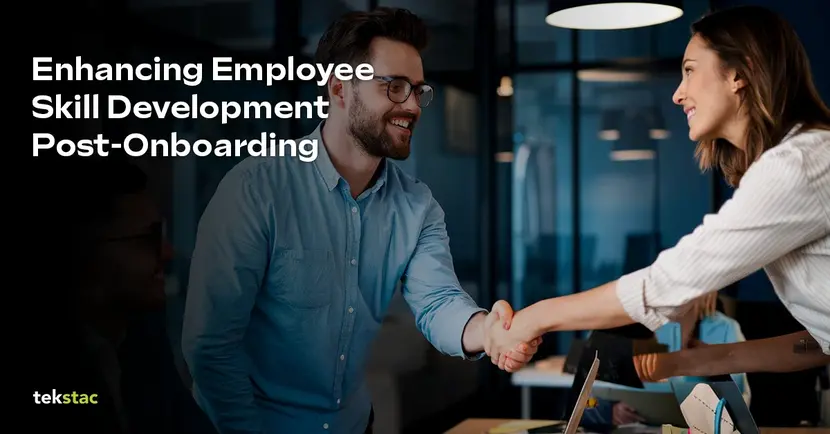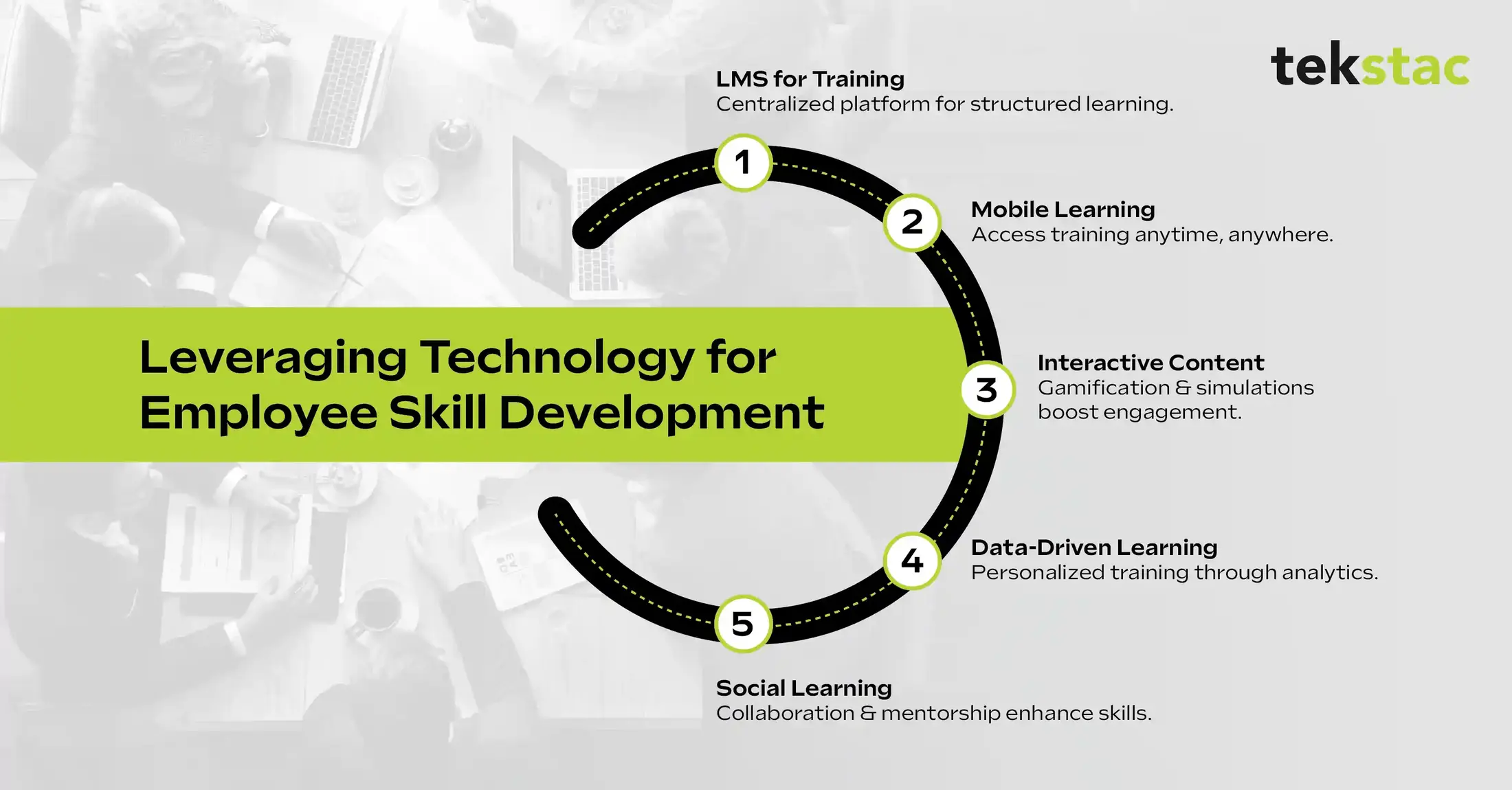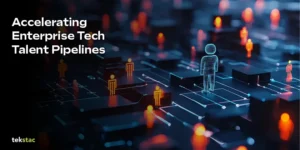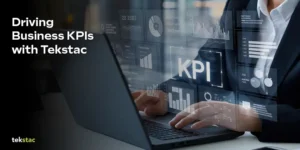Leveraging Technology for Employee Skill Development Post-Onboarding
December 30, 2024

In today’s tech-driven corporate world, employee skill development has moved beyond being a corporate necessity to being a critical advantage. For the HR and L&D executives of tech companies, the challenge is not only in effectively onboarding employees but also in providing continuous post-onboarding skill upgrades, which is in accordance with individual development and organizational goals. Technology has become the foundation of today’s training, providing tools and platforms that enable employee growth and enhance training ROI.
This article discusses the role of HR and L&D professionals in leveraging technology in a highly impactful way to drive employee skill development post-onboarding.
Why Continuous Employee Skill Development Matters Post-Onboarding
Although onboarding can often build the platform for new hires, studies indicate important shortfalls in existing procedures. According to the eLearning Industry State of Employee Experience, 4 in 10 employees found their onboarding training outdated, and 1 in 3 regretted joining the company during this phase. These statistics underscore the need for organizations to not only revamp their on-boarding strategies but also create a seamless continuum of learning post-onboarding.
Beyond onboarding, the need for continuous skill development arises from:
- Technological Evolution: With rapid evolution across industries, employees are required to advance with new tools, systems, and approaches.
- Retention and Engagement: Successful skill development programs encourage employees to be happy and decrease turnover.
- Compliance and Risk Mitigation: Many industries require ongoing training to meet regulatory standards.
Leveraging Technology to Enhance Employee Skill Development
For best results, HR and L&D executives will need to deliberately integrate technology, focusing on solutions that serve both organizational needs and learner needs.

1. Learning Management Systems (LMS): The Foundation of Digital Training
As per the 2023 Training Industry Report, 96% of large and mid-sized companies use Learning Management System (LMS) platforms for training management. These systems play the role of a centralized hub for organizing, distributing, and managing training content.
Nevertheless, the outcome of an LMS is determined by careful design and deployment. Barriers such as unnecessarily complicated user interfaces, absence of administrator support, and uninteresting workflows frequently stall LMS adoption. To address these, organizations should:
- Choose platforms with intuitive user interfaces and strong customer support.
- Make sure LMS functionalities allow personalized learning paths by distinguishing between required and optional courses.
- Incorporate gamification and interactive content tools to increase engagement.
For medium-size companies or who have special requirements, an all in one skilling platforms that combine LMS functionalities can be an option that ensures functionality and freedom.
2. Mobile Learning: Anytime, Anywhere Access
Mobile learning has changed the face of skill development as workers can access training anywhere, anytime. In a society where remote and hybrid work is the new normal, mobile-enabled platforms are available to serve varying learning styles and flexible scheduling needs.
Organizations should ensure mobile platforms:
- Provide bite-sized learning items to fit into hectic schedules.
- Include offline capabilities, allowing learning in low-connectivity areas.
- Give native integration with existing tools, e.g., Slack, Microsoft Teams, for collaborative learning.
3. Interactive Content: Driving Engagement and Retention
Employee engagement can so heavily depend on the training content’s relevance and interaction. Research indicates that the use of interactive components such as videos, simulations, and gamified quizzes enhances retention rates greatly.
For instance:
- Gamification fosters motivation through rewards, leaderboards, and challenges.
- Simulations provide risk-free opportunities for employees to practice skills in real life situations.
- Augmented Reality (AR) and Virtual Reality (VR) technologies are well suited for applications that have an element of “touch” to it (like engineering, or healthcare).
4. Data Analytics: Personalizing the Learning Journey
Perhaps the most revolutionary application of technology in training has been the implementation of data analytics for tailored learning pathways. Based on metrics, such as skills inventory, skills gap, personal skills profile, course completion percentage, quiz score, and level of engagement, organizations can:
- Identify knowledge gaps and tailor content accordingly.
- Predict future skill requirements and proactively design training.
- Offer real-time feedback to allow employees to measure their own progress and establish targets.
For instance, an employee who outperforms in pre-tests for some modules may be exempted from repetitive training procedures, saving time and frustration. This degree of personalization guarantees that learning is meaningful and desirable.
5. Social Learning: Leveraging Collaboration Tools
Collaborative platforms such as Slack, Microsoft Teams, or dedicated skilling forums can be leveraged to support peer-to-peer learning. Social learning fosters a sense of community, encouraging employees to share insights, discuss challenges, and learn from one another.
Key strategies include:
- Providing avenues for employees to discuss training topics through discussion forums.
- Supporting employees to participate with a success story or innovative use of what they have learned.
- Providing virtual mentorship programs that brings in new employees in contact with old employees.
Practical Considerations for Implementing Technology-Driven Learning
1. Align Technology with Organizational Needs
Not all training requires high-tech solutions. The process of conducting a feasibility study allows to know whether technology-as-a-solution fulfils the goals of the organization, objectives and budget. Key steps include:
- Reviewing training objectives and materials.
- Evaluating employee traits, and how they learn.
- Choosing tools to accommodate a wide range of content types such as video and audio, as well as real-time interaction.
2. Addressing Resistance to Change
Technological advancements are frequently met with resistance from both staff and managers. Overcome this by:
- Training for trainers to facilitate efficient platform adoption.
- Providing blended self-paced and instructor-led training for varying comfort levels.
- Proactively and methodically engaging and integrating employee input to enhance systems.
3. Invest in Continuous Improvement
Skill development is a process and not a one-time event. Continuously update training materials based on industry developments, feedback from employees, and changes in business requirements.
The Future of Employee Skill Development: A Hybrid Approach
Although technology is a great facilitator, it should not be used without human interface. Hybrid learning models-integrating digitally-based tools with face-to-face mentorship-provide an integrated approach. For instance, whereas a stand-alone upskilling content platform can provide basic knowledge, face-to-face workshops or individual coaching can be designed to tackle complex or subtle skills.
Conclusion: Building a Future-Ready Workforce
In today’s dynamic business environment, employee skill development is a continuous journey that demands strategic focus, thoughtful planning, and the right tools. Organizations that prioritize ongoing learning create a culture of adaptability and innovation, empowering their employees to meet current challenges and prepare for future opportunities.
To fulfill these objectives, companies need to adopt solutions that integrate modern technologies with pragmatic results. Platforms such as Tekstac illustrate this kind of thinking in that they provide end-to-end skilling solutions to help overcome, for example, some of the biggest challenges in workforce development. From immersive practice labs, to data-intensive evaluations, and real-time learning analytics, these platforms offer a scalable and formal means to talent transformation on a large scale.
By integrating advanced tools with carefully curated content and robust management features, organizations can ensure their training initiatives are both effective and sustainable. Working through skill gaps, nurturing innovation, or maximizing retention, a holistic platform approach can enable HR and L&D leaders to build talent teams prepared for the future of work.
The road to success in the end, rests in thoughtfully tech-enabled approaches that put the employee front and center of the learning experience-converting aspiration to action, skill by skill.
Employee Skill Development FAQs
1. What is the future of employee skill development?
The future is hybrid—blending digital platforms with human mentorship to offer scalable, personalized, and effective learning experiences.
2. Why is continuous skill development important after employee onboarding?
Continuous skill development ensures employees stay updated with evolving technologies, stay engaged, and perform at their best long after the onboarding phase.
3. What’s the best strategy for selecting tech tools for employee training?
Evaluate training goals, employee learning styles, and budget. Choose tools that support multimedia content, scalability, and personalization.
4. How can companies address resistance to new training technologies?
Provide adequate trainer support, blend self-paced with live training, and involve employees in feedback loops to build trust and adoption.





